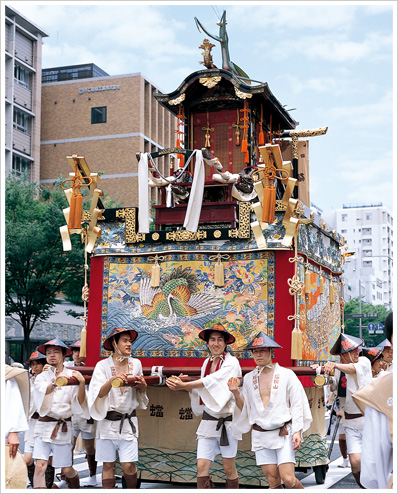蟷螂山は、「蟷螂の斧を以て隆車の隧を禦がんと欲す」という中国の故事にちなんでいる。その起源は南北朝時代で、足利義詮軍に挑んで戦死した当町在住の公卿、四条隆資(1292~1352)の戦いぶりが「蟷螂の斧」のようであったことから、渡来人で当町居住の陳外郎大年宗奇が卿の死後25年目の永和二年(1376)、四条家の御所車にその蟷螂を乗せて巡行したのがはじまりといわれる。
その後、蟷螂山は再三の戦火に遭うが、そのつど再興され、巡行を続けてきたのであるが、元治の大火(1864)でその大部分を焼失してしまい、昭和56年、117年ぶりに再興された。
蟷螂山の特徴は、かまきりと御所車の車輪が動くなど、祇園祭の山鉾としては、唯一のからくりが施されていることである。前懸、胴懸、見送は共に羽田登喜男作の友禅で、瑞苑浮遊図などがある。
This float derives its name from an old saying in China that a praying mantis, though small, is courageous enough to raise its ‘hatchets’ high in the air and stand in front of a marching army to try to stop it.
The origin of this float dates back to the mid-14th century, when Shijo Takasuke (1292-1352), a high-ranking aristocrat from this neighborhood, courageously fought for a cause and was killed. A rich local merchant named Chin-uirou Tainensouki, who was an immigrant from China, sympathetically associated Shijo Takasuke with the proverbial praying mantis (known as a “Toro” or “Kamakiri” in Japanese), and made a figure of the insect. The praying mantis figure was displayed on a cart owned by the Shijo family, and paraded along with Gion festival floats in 1376, the 25th anniversary of the death of the valorous courtier.
The greatest feature of this float is the fact that the praying mantis and the wheels of the mounted court cart are linked to move together mechanically, which is unique among the Gion floats.
公式サイトはこちら




